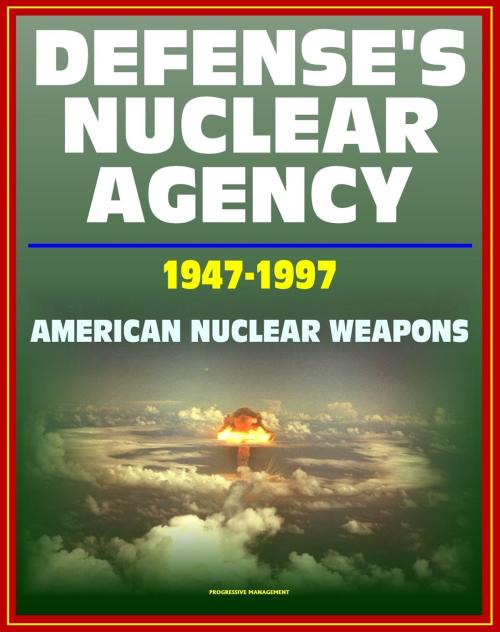Defense's Nuclear Agency 1947: 1997: Comprehensive History of Cold War Nuclear Weapon Development and Testing, Atomic and Hydrogen Bomb Development, Post-War Treaties
Nonfiction, Science & Nature, Science, Physics, Nuclear Physics, History, Military, Nuclear Warfare| Author: | Progressive Management | ISBN: | 9781476416687 |
| Publisher: | Progressive Management | Publication: | March 30, 2012 |
| Imprint: | Smashwords Edition | Language: | English |
| Author: | Progressive Management |
| ISBN: | 9781476416687 |
| Publisher: | Progressive Management |
| Publication: | March 30, 2012 |
| Imprint: | Smashwords Edition |
| Language: | English |
The Defense Nuclear Agency presents a comprehensive and informative history of the development and testing of nuclear weapons after World War II, from the earliest atomic bombs through the devastating hydrogen thermonuclear devices that were the centerpiece of the Cold War. It provides unique insights into civilian and presidential decisions from Truman through Clinton.
Contents: CHAPTER ONE - The Post-War Transition, 1946 to 1948 * CHAPTER TWO - The Military's Role in Nuclear Matters, 1949 to 1952 * CHAPTER THREE - The Sprint for Supremacy, 1952 to 1957 * CHAPTER FOUR - Some Second Thoughts, 1957 to 1963 * CHAPTER FIVE - A New Paradigm, 1963 to 1970 * CHAPTER SIX - Another Way, 1970 to 1980 * CHAPTER SEVEN - A Rebirth of Confidence, 1980 to 1988 * CHAPTER EIGHT Post-Cold War Era: New Missions, 1989 to 1997
Defense's Nuclear Agency, 1947-1997, traces the development of the Armed Forces Special Weapons Project (AFSWP), and its descendant government organizations, from its original founding in 1947 to 1997. After the disestablishment of the Manhattan Engineering District (MED) in 1947, AFSWP was formed to provide military training in nuclear weapons' operations. Over the years, its sequential descendant organizations have been the Defense Atomic Support Agency (DASA) from 1959 to 1971, the Defense Nuclear Agency (DNA) from 1971 to 1996, and the Defense Special Weapons Agency (DSWA) from 1996 to 1998. In 1998, DSWA, the On-Site Inspection Agency, the Defense Technology Security Administration, and selected elements of the Office of Secretary of Defense were combined to form the Defense Threat Reduction Agency (DTRA).
The Prologue sets the stage for the national and international events leading up to the founding of AFSWP in 1947. The history of AFSWP and its descendant organizations is presented in eight narrative chapters that cover logical periods of evolution and development. These chapters are followed by appendices that provide further background on organizational transitions, including charters, chronology, and an agency time line. Chapters are arranged in chronological order and cover the evolution of the agency, as portrayed against the larger backdrop of military and political currents. Each chapter addresses external influences, internal program response, ancillary programs, and transitions. Issues that overlap chapters are revisited. Although it is difficult at times to separate the agency's mission from the larger Department of Defense (DoD) or the Atomic Energy Commission (AEC), the text is centrally focused upon the department's nuclear agency over five decades, 1947-1997. Technical issues and terms, so much a part of a technical defense agency, have been held to a minimum; an abbreviation/acronym list is provided in the appendix for reference.
The Defense Nuclear Agency presents a comprehensive and informative history of the development and testing of nuclear weapons after World War II, from the earliest atomic bombs through the devastating hydrogen thermonuclear devices that were the centerpiece of the Cold War. It provides unique insights into civilian and presidential decisions from Truman through Clinton.
Contents: CHAPTER ONE - The Post-War Transition, 1946 to 1948 * CHAPTER TWO - The Military's Role in Nuclear Matters, 1949 to 1952 * CHAPTER THREE - The Sprint for Supremacy, 1952 to 1957 * CHAPTER FOUR - Some Second Thoughts, 1957 to 1963 * CHAPTER FIVE - A New Paradigm, 1963 to 1970 * CHAPTER SIX - Another Way, 1970 to 1980 * CHAPTER SEVEN - A Rebirth of Confidence, 1980 to 1988 * CHAPTER EIGHT Post-Cold War Era: New Missions, 1989 to 1997
Defense's Nuclear Agency, 1947-1997, traces the development of the Armed Forces Special Weapons Project (AFSWP), and its descendant government organizations, from its original founding in 1947 to 1997. After the disestablishment of the Manhattan Engineering District (MED) in 1947, AFSWP was formed to provide military training in nuclear weapons' operations. Over the years, its sequential descendant organizations have been the Defense Atomic Support Agency (DASA) from 1959 to 1971, the Defense Nuclear Agency (DNA) from 1971 to 1996, and the Defense Special Weapons Agency (DSWA) from 1996 to 1998. In 1998, DSWA, the On-Site Inspection Agency, the Defense Technology Security Administration, and selected elements of the Office of Secretary of Defense were combined to form the Defense Threat Reduction Agency (DTRA).
The Prologue sets the stage for the national and international events leading up to the founding of AFSWP in 1947. The history of AFSWP and its descendant organizations is presented in eight narrative chapters that cover logical periods of evolution and development. These chapters are followed by appendices that provide further background on organizational transitions, including charters, chronology, and an agency time line. Chapters are arranged in chronological order and cover the evolution of the agency, as portrayed against the larger backdrop of military and political currents. Each chapter addresses external influences, internal program response, ancillary programs, and transitions. Issues that overlap chapters are revisited. Although it is difficult at times to separate the agency's mission from the larger Department of Defense (DoD) or the Atomic Energy Commission (AEC), the text is centrally focused upon the department's nuclear agency over five decades, 1947-1997. Technical issues and terms, so much a part of a technical defense agency, have been held to a minimum; an abbreviation/acronym list is provided in the appendix for reference.















